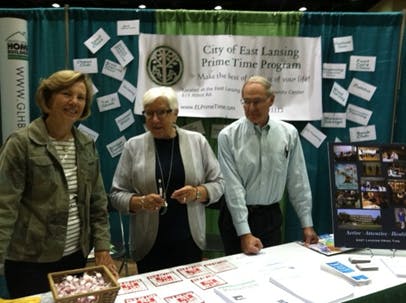Many East Lansing residents go through doorways and live in apartments without realizing the barriers common designs present to older members of the community.
Through the Age-Friendly Community Committee, citizens and government leaders are working to improve accessibility and bridge the generational gap.
The City of East Lansing created the committee in 2017 to continue working toward an Age-Friendly Community designation, which the World Health Organization, or WHO, describes in a 76-page guide. While the problem is described by the WHO through a global lens, they aim to inspire communities to improve access for their own aging populations.
“The world is rapidly aging. The number of people aged 60 and over as a proportion of the global population will double from 11 percent in 2006 to 22 percent by 2050,” according to the guide.
The 65-and-over age group made up an estimated 7 percent of East Lansing’s population in 2018, according to census data.
WHO guidelines are separated into multiple parts, reflected in the Action Plan Subcommittees created within East Lansing’s main committee.
Subcommittees include housing, transportation, communications and information, social participation, respect and social inclusion, community support and health services, outdoor spaces and buildings, and civic participation and employment.
Becoming an age-friendly community takes about five years, according to Kelly Arndt, director of the Prime Time Seniors’ Program. Prime Time has been a driving force behind the committee’s efforts.
East Lansing has taken further steps in its efforts for the designation. The city joined the AARP Network of Age-Friendly Communities in 2017.
However, the committee’s focus is not solely to improve life for senior citizens.
“An Age-Friendly Community is a community for all ages,” Arndt said.
Arndt spoke to the idea of universal design, which addresses livability issues that cross generations but make specific accommodations for older citizens.
Examples of projects include making doors to businesses downtown easier to open, she said. Seniors in focus groups said housing was another primary issue.
Finding an accessible place to live is often “not even on your radar, but as you age, that becomes difficult,” she said.
Janet Lee, a recent retiree from Okemos Public Schools, agrees.
“As you grow older, and if you have a cane or if you’re in a wheelchair, you need doorways to be wider than they traditionally are,” Lee said.
She is a member of the steering committee, which is primarily made up of local volunteers. She is also a member of the housing and social inclusion subcommittees.
Lori Strom was also on the steering committee and represented MSU, from which she has since retired.
“What really stood out was that a majority of folks want to remain in their own home and that they would appreciate having various options which would give them access to the community,” she said.
Bailey Center Senior Apartments resident Lana Schaeffer provided input for the committee in its earlier stages. She mentioned ideas that link different age groups together, like Art Buddies, which pairs seniors at Prime Time with local students in special education programs, connecting them through art projects.
Support student media!
Please consider donating to The State News and help fund the future of journalism.
“We try to have some projects that include cross-generational participation,” she said.
Schaeffer also has concerns about housing. She moved to the Bailey Center and soon realized the height of the kitchen bar was too tall for her to use.
“Old people aren’t going to climb up on a 50-inch barstool to eat dinner,” she said.
Strom said people in the community are mostly satisfied with accessibility, but some want the city to go further and make more changes.
Councilmember Aaron Stephens supported the committee and its work.
“It’s important for us to make sure that every member of our community is not only included in the community but has accessibility to the community,” he said.
Action plans were recently sent to the planning department, which puts the committee in the process of receiving the designation by the WHO. The city council will provide recommendations to the committee and possibly tweak any ideas presented, Arndt said.
“Projects like this help us to be mindful of others in the community,” Arndt said.
Discussion
Share and discuss “Age-Friendly Community Committee aims to increase accessibility” on social media.






